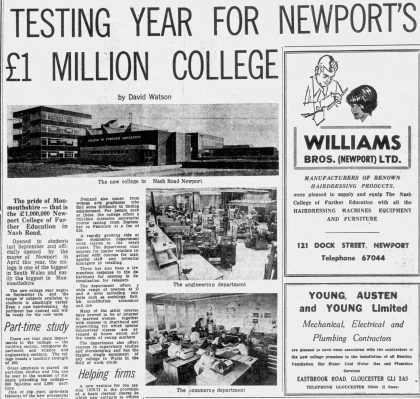Bryngwyn Farm Lliswerry
Former farm on nash road
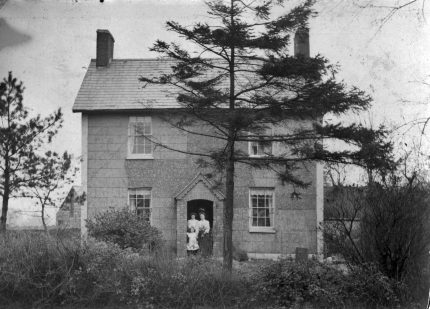
Bryngwyn Farm once stood proudly on Nash Road in Lliswerry, with a substantial main road frontage, 200 acres of land and a thriving orchard, it was a significant agricultural property. Today, the land where the farmhouse and orchard once stood is home to Lliswerry High School, while some of the surrounding fields have been transformed into school sports pitches.
The farm, built in the mid-19th century, was home to the Phillips family for nearly a century. Our second great-grandparents, Ebenezer and Catherine Phillips, lived there in the late 19th century, and our great-grandmother, Catherine Phillips, was born at Bryngwyn in 1871.
Agricultural Landscape
Lliswerry, now a bustling suburb of Newport, was once a peaceful rural landscape, almost unrecognisable from what it is today. The name Lliswerry is an anglicised version of the Welsh Llyswyry, meaning Maiden’s Court, believed to reference a former manor house linked to the Welsh King of Brycheiniog. In the 19th century, Lliswerry was an area defined by agriculture. The land was dotted with farms – Bryngwyn, Upper Lakes, Lower Lakes, and Spitty Farm among them. Expanses of open fields, woodland, and natural lakes shaped the scenery, with only the occasional farmhouse, barn, or cottage breaking the rural silence.
Over time, this tranquil agricultural region gave way to modern development. Today, the landscape is dominated by the Leeway Industrial Estate, Newport Retail Park, Newport College of Further Education, and Lliswerry High School. Busy roads and bypasses now crisscross the area, making it one of the city’s most active commercial and educational suburbs. Yet, despite the transformation, a few green pockets remain – offering a glimpse of the past. The site once occupied by Bryngwyn Farm’s farmhouse is now home to the main building of Lliswerry High School, a striking contrast between past and present.
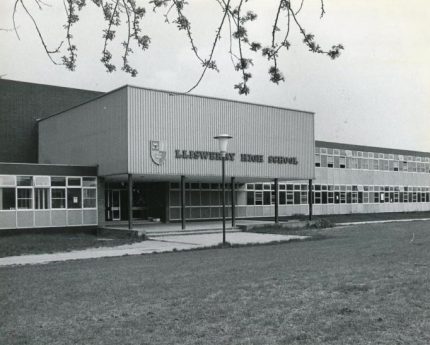
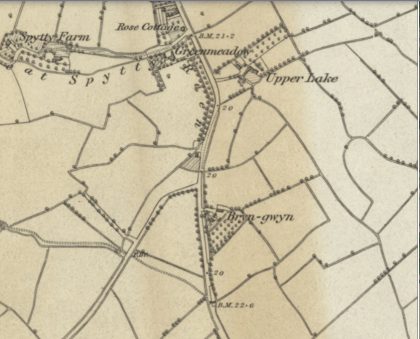
A Substantial Farm
Historical records, including census data, show that Bryngwyn Farm once encompassed 200 acres. Over time, the estate shrank as portions were sold off, including land opposite the farm where a housing estate now sits. A 1903 sale notice that marketed Bryngwyn Farm to developers gives us the fullest description of the property. It offered two lots for sale:
Lot One included the farmhouse, stables, cattle sheds, piggery, cart shed, a well-established orchard, and 40 acres of fertile pasture, all with 1,000 feet of frontage on Nash Road. Lot Two offered 20 acres of valuable freehold building land with 800 feet of road frontage. Despite being marketed as building land, the Phillips family were not finished at Bryngwyn Farm, they purchased it and remained farming at Bryngwyn for another 60 years.
Ebenezer Phillips
Born in 1846, Ebenezer was the fourth child of William Phillips and Rebecca Ashfield of Nash. He was raised on the family’s small farm and married Catherine Alice Morgan Williams in 1868. His wife Catherine was born in 1854, the daughter of Lewis Williams of Spitty Farm and Catherine Morgan. Initially living with Lewis at Spitty Farm, the couple soon moved to Bryngwyn, which Ebenezer owned jointly with his father-in-law, the two also bred and sold horses from Spitty Farm.
In 1875, Ebenezer had a tumultuous year – there was positive news when he successfully sued the Monmouthshire Rail and Canal Company over ruined hay at Bryngwyn. However, he was also convicted of assault following a confrontation after a night out and further trouble followed when he was later fined for being drunk and disorderly after a brawl at the King of Prussia pub in Somerton.
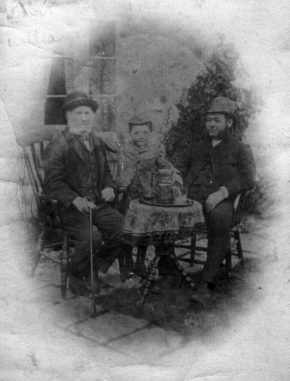
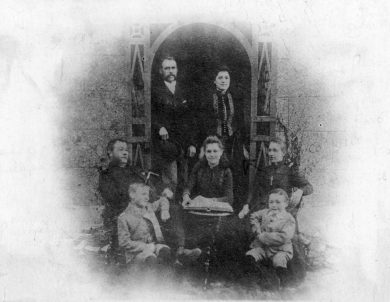
Farming Success
Despite these incidents, Ebenezer was a successful and respected farmer. Bryngwyn Farm’s orchard and pastureland were profitable, and he secured various town council contracts for fencing work in Nash and the marshes. He amassed considerable wealth and played a prominent role in local life, serving nearly a decade as a councillor, often unopposed.
By the 1881 census, Ebenezer and Catherine were living at the farm with their children: Catherine (b. 1871), Susannah (1873), Beatrice (1877), and Ebenezer Jr. (1879). Catherine’s father, Lewis, now retired, also lived with them. Their final child, Charles (known as Fred), was born in 1882.
A Second Marriage and Final Years
Catherine died at the farm in 1896, she was just 42. In 1900, Ebenezer remarried at age 54. His new wife, Kate, aged 30 was originally from Kent and she moved to Bryngwyn to join her new husband and stepson Fred. While celebrating his second marriage in a Maindee pub, Ebenezer infamously fired a loaded revolver into a glass display case containing stuffed birds, resulting in another court case and fine.
The 1901 census lists Ebenezer, Kate, and Fred living at Bryngwyn. Ebenezer died the following year, aged 56, after a long struggle with alcohol. His estate, valued at £4,359 (about £450,000 today), was administered by John Ford Haine of Upper Lakes Farm and Lewis Augustus Williams, his brother-in-law from Spitty Farm. All of Ebenezer’s live and dead stock, plus farm implements and hay were sold at auction on August 28th 1902.
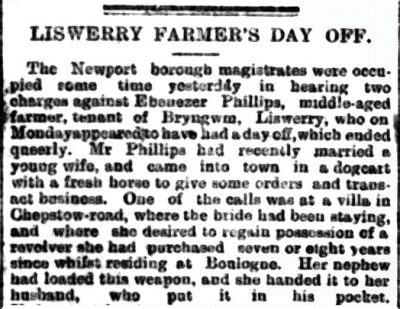
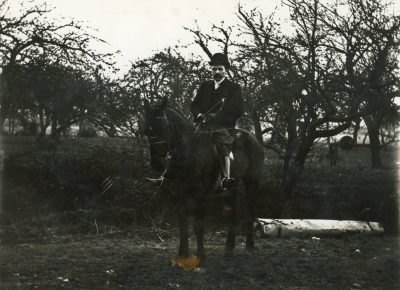
Fred Phillips and the Next Generation
Fred Phillips lived at Bryngwyn Farm after his father’s death and purchased it at auction with his inheritance. He married Rose Ethel Price in 1901 at St John the Baptist Church in Cardiff. Fred and Rose had two daughters: Beatrice May (b. 1902) and Catherine (b. 1905), though sadly the younger died in infancy. On the 1911 census the family were living at the farm with Fred’s uncle, Lewis A. Williams, who helped run operations.
Fred continued his father’s legacy, winning prizes for livestock and running a successful dairy. His daughter May worked in the dairy until her marriage in 1926. In 1934, a hayrick fire broke out on the farm, taking fire crews two hours to extinguish. There was further drama in 1938 when an alert police constable prevented an early morning potato theft at the farm! Fred Phillips remained at Bryngwyn for his entire life, passing away at the farm on January 3rd 1955 at the age of 73.
From Farming to Learning
Farming at Bryngwyn continued into the 1960s. and in 1963 the farm hosted a lively barn dance. However, major change was on the horizon. In 1965, plans were announced for a £1 million new college – Newport College of Further Education – which opened in 1969 on land that once belonged to Bryngwyn and Upper Lakes Farms. The four-storey college building dwarfed the remaining farm structures and neighbouring homes.
In 1971, 17 acres of Bryngwyn farmland was purchased by Terence A. Johnsey Limited of Newport. They were a major Newport development company who built the Leeway Industrial estate and Newport Retail Park. Bryngwyn farmhouse was then demolished to make way for Lliswerry High School, which was completed in 1974. The main school building now sits on the very site once occupied by the farmhouse and orchard.
Something to add to the story of Bryngwyn Farm? Please email us: research@skinnerfamilyhistory.com
